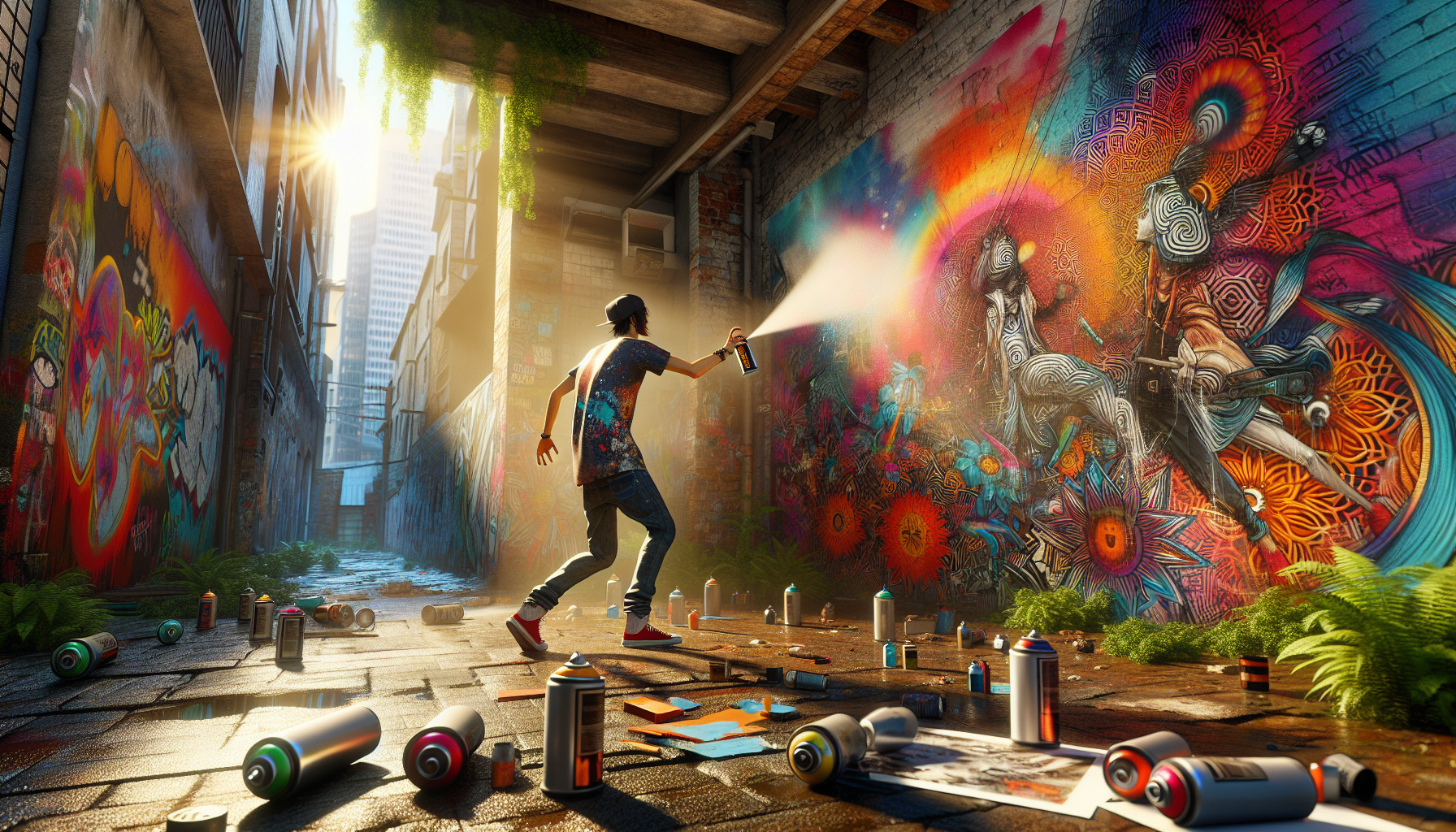Anúncios
In a world where creativity knows no bounds, the blank canvas of your home or workspace eagerly awaits its transformation. Imagine stepping into a room that reflects not only your personality but also your artistic flair—an environment that inspires, motivates, and revitalizes you every day. This metamorphosis might seem daunting, yet it can be achieved with tools as simple and accessible as spray paint and stencils. 🎨 These dynamic instruments offer a gateway to revolutionizing your space, transforming the mundane into the extraordinary with just a few sprays and strokes.
Anúncios
Spray paint, often seen as the rebellious cousin in the paint family, brings with it an element of spontaneity and daring. Its bold, vibrant colors can instantly invigorate a tired piece of furniture, an old bicycle, or even an entire wall. Meanwhile, stencils provide precision and consistency, allowing intricate designs to unfold with ease. Together, these tools break down the barriers of traditional design, enabling you to create art that is both structured and free-flowing. The possibilities are endless, limited only by your imagination.
Anúncios
In this article, we delve into the transformative power of spray paint and stencil interventions, exploring how they can breathe new life into your surroundings. We’ll begin by guiding you through the basics—selecting the right materials, understanding the techniques, and setting up your workspace. Whether you are a seasoned artist or a curious beginner, these foundational steps are crucial in ensuring your project’s success.
Next, we’ll journey into the creative process itself, offering inspiration and ideas to spark your imagination. From revamping a drab kitchen with a pop of color to creating a whimsical garden mural, we’ll showcase a variety of projects that demonstrate the versatility of spray paint and stencils. Along the way, we’ll share tips and tricks from experienced DIY enthusiasts and professional artists, providing you with the insights needed to overcome common challenges and achieve stunning results.
Finally, we’ll explore the impact of your creative endeavors, not only on your space but also on your well-being. Embracing your artistic side can be a deeply fulfilling experience, fostering a sense of accomplishment and pride in your surroundings. By the end of this article, you’ll be equipped with the knowledge and inspiration to embark on your own creative journey, ready to revolutionize your space and unleash your inner artist. ✨ Let’s dive in and discover the art of transformation, one spray at a time.
The Power of Spray Paint and Stencil Art
Spray paint and stencil art have emerged as powerful tools for transforming spaces in both urban and domestic environments. This form of artistic expression allows for the rapid creation of intricate designs, and its versatility makes it suitable for a wide range of applications, from graffiti on city walls to detailed artwork on furniture. One of the most appealing aspects of spray paint art is its accessibility; anyone with a can of spray paint and a stencil can unleash their creativity and add vibrant colors and patterns to their surroundings. 🌈
Spray paint has been a staple in the world of street art for decades, thanks to its ability to cover large areas quickly and its vibrant color palette. It provides artists with the flexibility to work on different surfaces, whether it’s a concrete wall or a wooden canvas. The ease of use and speed of application make spray paint an attractive medium for artists looking to create bold statements. Stencils, on the other hand, bring precision and repeatability to the table, allowing artists to reproduce intricate designs consistently. When combined, these two tools offer endless possibilities for artistic expression.
Moreover, the use of spray paint and stencils is not limited to professional artists. Hobbyists and DIY enthusiasts have also embraced these tools to personalize their living spaces. From creating custom wall art in a bedroom to designing unique patterns on a patio floor, spray paint and stencil interventions provide a quick and effective way to refresh and customize any area. The following table compares the advantages of spray paint and stencil art in various settings:
| Aspect | Spray Paint | Stencil Art |
|---|---|---|
| Speed | Fast application | Precision over speed |
| Versatility | Multiple surfaces | Reproducible designs |
| Accessibility | Easy to use for beginners | Requires design preparation |
Feeling inspired? Check out the video below to see spray paint and stencil art in action:
Watch “Creative Stencil Art Tutorial” by Art of Spray
Transforming Urban Landscapes with Spray Paint
Urban landscapes provide an expansive canvas for artists to express their creativity, and spray paint has played a pivotal role in transforming these spaces. Cities around the world have embraced street art as a legitimate form of artistic expression, often commissioning artists to create murals that reflect local culture and history. These large-scale artworks not only beautify the urban environment but also foster a sense of community and identity among residents.
Spray paint murals can be found on the sides of buildings, in alleyways, and even on public transportation. These artworks often carry powerful messages or tell stories that resonate with the local community. In some cases, they serve as a form of protest or social commentary, addressing issues such as inequality, climate change, and human rights. The ephemeral nature of street art also adds to its allure; these pieces can be temporary, changing with the seasons or the tides of public opinion.
Despite the transitory nature of some street art, many cities have recognized its value and have taken steps to preserve notable works. This has led to the establishment of street art festivals and exhibitions, drawing tourists and art enthusiasts from around the globe. The following list highlights some of the key benefits of incorporating spray paint art into urban settings:
- Enhances the aesthetic appeal of public spaces
- Promotes cultural expression and diversity
- Encourages community engagement and interaction
- Boosts tourism and local economy
Personalizing Your Home with Stencil Interventions
While spray paint is often associated with large-scale street art, it can also be used to personalize and enhance interior spaces. Stencil interventions offer a creative way to add unique patterns and designs to your home, whether it’s a subtle accent on a feature wall or a bold statement piece in a living room. The versatility of stencils allows for endless design possibilities, from geometric shapes to intricate floral motifs.
Using stencils in home decor is not only cost-effective but also allows for a high degree of customization. You can choose colors that complement your existing decor, or experiment with bold contrasts to create a striking visual impact. Additionally, stencils can be used on a variety of surfaces, including walls, floors, furniture, and even fabrics. This makes it easy to coordinate your design theme throughout different areas of your home.
To get started with stencil art at home, you’ll need to gather a few supplies: stencil templates, spray paint, painter’s tape, and protective gear like gloves and masks. Begin by selecting a design that suits your style and the space you want to transform. Secure the stencil in place with painter’s tape, and apply the spray paint evenly, taking care not to oversaturate the stencil. Once the paint is dry, carefully remove the stencil to reveal your masterpiece. For more detailed guidance, watch the following video on stencil techniques:
Watch “Stencil Techniques for Home Decor” by DIY Delight
In summary, spray paint and stencil art offer a dynamic and accessible way to revolutionize spaces, both urban and domestic. Whether you’re an aspiring artist or simply looking to add a personal touch to your home, these creative tools provide endless opportunities for expression and innovation.

Conclusion
In conclusion, the exploration of transforming spaces with the dynamic duo of spray paint and stencil interventions presents a powerful avenue for creativity and personal expression. As we’ve navigated through the article, several key points have emerged, each underscoring the transformative potential inherent in these artistic techniques.
Firstly, we delved into the history and evolution of spray paint and stenciling, noting how these methods have transcended their roots in street art to become respected tools in both professional and amateur art circles. This evolution highlights not only their versatility but also their ability to democratize art, making it accessible to anyone with a vision and a desire to transform their surroundings.
Furthermore, we examined the technical aspects of using spray paint and stencils, emphasizing the importance of preparation, practice, and precision. From selecting the right materials to mastering the techniques of layering and blending, each step is crucial in achieving the desired outcome. These technical skills, when honed, allow for the creation of stunning visual effects that can completely alter the atmosphere of a space.
In addition to technique, the article explored the myriad applications of spray paint and stencils, from home décor to large-scale public art projects. The versatility of these tools means that they can be used to refresh a piece of furniture, add a personal touch to a room, or even engage a community through collaborative mural projects. This adaptability underscores the relevance of spray paint and stencil art in today’s diverse artistic landscape.
The environmental considerations associated with spray paint were also addressed, noting the advances in eco-friendly products and methods that minimize health risks and environmental impact. This aspect is crucial for responsible artistry and highlights the importance of staying informed about sustainable practices.
Moreover, the article showcased inspiring examples of artists and projects that have harnessed the power of spray paint and stencils to create breathtaking works of art. These case studies serve not only as a source of inspiration but also as a testament to the impact that these techniques can have in terms of aesthetic appeal and cultural significance.
In reinforcing the importance of this theme, it is clear that the use of spray paint and stencils goes beyond mere decoration. It is a form of self-expression and empowerment, allowing individuals to imprint their identity onto their surroundings. In a world where individuality is often overshadowed by mass production and uniformity, these tools offer a means to reclaim personal space and express uniqueness.
Finally, the creative process associated with spray paint and stencils can also have profound therapeutic benefits. Engaging in art has been shown to reduce stress and enhance mental well-being, making this practice not only an artistic endeavor but also a pathway to personal wellness.
As we wrap up this exploration, I encourage you, the reader, to embrace the possibilities presented by spray paint and stencil art. Whether you’re an experienced artist or a curious beginner, there’s a wealth of potential waiting to be unlocked. Experiment with colors, designs, and surfaces to discover your own artistic voice.
I invite you to share your experiences and creations in the comments below. Engage with others who share your passion and perhaps collaborate on future projects. If this article has sparked your interest or provided new insights, consider sharing it with friends or on social media to spread the inspiration.
In applying what you’ve learned, remember that creativity knows no bounds. Use spray paint and stencils as a means to transform not just physical spaces, but also to inspire change within yourself and your community. Let your creativity flow, and watch as it revolutionizes the world around you. ✨
For more information on eco-friendly spray paint options and techniques, you can visit reputable sources like Montana Colors and Stencil Revolution. Additionally, if you’re interested in exploring the therapeutic benefits of art, consider reading resources from Psychology Today.
Thank you for embarking on this creative journey with us. Keep painting, keep stenciling, and most importantly, keep creating. 🎨
